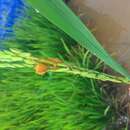pms
nòm ant ël fil


Ustilaginoidea virens, perfect sexual stage Villosiclava virens,[1] is a plant pathogen which causes the disease "false smut" of rice which reduces both grain yield and grain quality. The disease occurs in more than 40 countries, especially in the rice producing countries of Asia.[2] but also in the U.S.[3] As the common name suggests, it is not a true smut (fungus), but an ascomycete. False smut does not replace all or part of the kernel with a mass of black spores, rather sori form erupting through the palea and lemma forming a ball of mycelia, the outermost layers are spore-producing.[4] Infected rice kernels are always destroyed by the disease.
Of particular concern are the production of alkaloids in the grain as with the Claviceps spp. causing ergot however U. virens is not a Claviceps/ergot fungus, is not known to produce ergotism, and lacks enzymes necessary in ergot synthesis.[5]
Although U. virens does infect maize/corn,[6] it does not do so often,[6] produce significant disease,[6] or have economic consequences.[6]
U. virens has a peculiar life cycle. White hyphae are produced by the fungi after initial infection of the floral organs of the rice crop. As the infection matures with time, darker brownish green chlamydospores are produced on the rice spikelets. Additionally, sclerotia can be present towards the end of the fall season. During its life cycle, U. virens undergoes a sexual (ascospores) stage as well as an asexual (chlamydospores) stage. The chlamydospores are the main survival structure, and they can live in the soil for up to four months. The additional formation of sclerotia allows U. virens to survive even longer, almost up to a year. These sclerotia, which can be present either on or below the surface of the soil, mature to form an ascocarp (fruiting body). The ascospores from these fruiting bodies act as the primary source of infection to spread disease throughout the paddy field.
The rice false smut pathogen, Ustilaginoidea virens, invades through a small gap at the apex of a rice spikelet before heading.[7] The primary source of infection is the presence of chlamydospores in the soil.[8] During the vegetative stage of the growth of the rice crop, the fungus colonizes the tissue on the growing points on the tillers.[8] This happens when conidia get deposited on the spikelets of the rice crop, which later lead to the growth of hyphae. The mycelia from these hyphae invade the floral organs in the spikelets.
The rice false smut pathogen causes mostly qualitative damage to the rice crop. Removal of the brown "smut balls" is important to maintain the visual integrity of the harvested crop. Additionally, certain steps can be taken to manage and/or prevent the onset of disease. Most rice varieties are susceptible to the disease; however, some cultivars of rice provide a small amount of resistance against U. virens.[9] As of 2019 there are still no known resistant cultivars, with the very best being only of "moderate" susceptibility.[10] Planting rice earlier in the season can also reduce the amount of disease caused by false smut. In some studies, rice planted in April showed much less presence of false smut than rice planted after 15 May. As is the case for most rice diseases, large amounts of fertilizer in the soil lead to increase in disease.[9] Maintaining the nitrogen rate in the soil to a level below 160 pounds per acre has proven to be most efficient against stopping disease.[9] Although there are no specific fungicide recommendations for the eradication of the false smut pathogen of rice, Cartwright reported that propiconazole was the most effective ingredient after studying it for over three years.[9]
Ustilaginoidea virens, perfect sexual stage Villosiclava virens, is a plant pathogen which causes the disease "false smut" of rice which reduces both grain yield and grain quality. The disease occurs in more than 40 countries, especially in the rice producing countries of Asia. but also in the U.S. As the common name suggests, it is not a true smut (fungus), but an ascomycete. False smut does not replace all or part of the kernel with a mass of black spores, rather sori form erupting through the palea and lemma forming a ball of mycelia, the outermost layers are spore-producing. Infected rice kernels are always destroyed by the disease.
Of particular concern are the production of alkaloids in the grain as with the Claviceps spp. causing ergot however U. virens is not a Claviceps/ergot fungus, is not known to produce ergotism, and lacks enzymes necessary in ergot synthesis.
Although U. virens does infect maize/corn, it does not do so often, produce significant disease, or have economic consequences.
Villosiclava virens estas parazito de floroj de rizo. Ĝia anamorfo estas Ustilaginoidea virens. [1] Sporoj infektas la spiketojn. Ili eniras per la stamentigoj[2].
Oni trovas gastigantojn en la subfamilio Ehrhartoideae kaj ankaŭ en Panicoideae, ekzemple Echinochloa crus-galli, Panicum tripheron, Imperata cylindrica aŭ Digitaria marginata.
Villosiclava virens estas parazito de floroj de rizo. Ĝia anamorfo estas Ustilaginoidea virens. Sporoj infektas la spiketojn. Ili eniras per la stamentigoj.
Ustilaginoidea virens je grzib[8], co go nojprzōd ôpisoł Mordecai Cubitt Cooke, a terŏźnõ nazwã doł mu Takah. 1896. Ustilaginoidea virens nŏleży do zorty Ustilaginoidea, rzyndu Hypocreales, klasy Sordariomycetes, grōmady Ascomycota i krōlestwa grzibōw.[9][10] Żŏdne podgatōnki niy sōm wymianowane we Catalogue of Life.[9]
Ustilaginoidea virens je grzib, co go nojprzōd ôpisoł Mordecai Cubitt Cooke, a terŏźnõ nazwã doł mu Takah. 1896. Ustilaginoidea virens nŏleży do zorty Ustilaginoidea, rzyndu Hypocreales, klasy Sordariomycetes, grōmady Ascomycota i krōlestwa grzibōw. Żŏdne podgatōnki niy sōm wymianowane we Catalogue of Life.
稲こうじ病(稲麹病)とは、イネに発生する主要な病気の1つ。「いなこうじ」と呼ばれ、英語では、「イネにせ黒穂病(Rice false smut)」、中国語では「稻曲病(曲は麹の簡体字)と表記される。世界中の稲作地帯から発生が報告されている。
イネの籾に暗緑色の厚膜胞子の固まりである病粒(偽菌核)を形成する。ひとつの穂に1〜10粒程度の病粒ができ、他の籾には外見上影響がみられないが、不稔などの症状が見られることがある[1]。イネの穂ばらみ期から出穂期の低温・多雨状態の時に発生が多くなる傾向がある。稲こうじ病による病籾が収穫籾に混入すると規格外となるため、経済的被害が大きい。文書には明時代の本草綱目に硬穀奴として記録がある。
稲こうじ病は、イネが稲こうじ病菌(学名:完全世代Villosiclava virens 、アナモルフUstilaginoidea virens、シノニムClaviceps virens、C. oryzae-sativaeなど)に感染し発病することで起きる。稲こうじ病菌はカビの一種であり、子嚢菌門、バッカクキン科に分類される。稲こうじ病の病粒は黒穂病と外見が似ているが、黒穂病菌は担子菌門の菌である。
稲こうじ病の病粒は厚膜胞子である。厚膜胞子は成熟にしたがって黄色から橙色を経て暗緑色に変化する。この厚膜胞子が土壌に混入して翌年以降の感染源になると考えられる。そのため、発病後に薬剤を散布しても効果はない。厚膜胞子は培養すると二次分生子を形成する。また病粒にはバッカクキンに類似する菌核が形成されることがある。この菌核は実験条件下では越年して完全世代の子実体を形成する。この子実体から子のう胞子が形成される。現在までに感染サイクルは解明されていない。防除対策としては、出穂期以前の予防的薬剤散布や耕種的防除法をおこなう。
稲こうじ病菌はバッカクキン科のカビであり、米麹などを作るコウジカビとは全く関係がない。「稲麹」という名称が誤解を与えるため、麹菌の野生種と混同されている事例がみられる。稲こうじ病菌自体がウスチロキシンというマイコトキシンを産生するため人体に有毒である。また、稲麹の病粒から分離したカビを用いて醸造する手法が知られているが、たまたま混入したコウジカビ類の菌を利用したものと考えられる。この場合も、野外のコウジカビ類(Aspergillus flavusなど)にはアフラトキシンやオクラトキシンなどのマイコトキシンを産生するものがあるため、稲麹を用いることは危険である。[要出典]
稲こうじ病(稲麹病)とは、イネに発生する主要な病気の1つ。「いなこうじ」と呼ばれ、英語では、「イネにせ黒穂病(Rice false smut)」、中国語では「稻曲病(曲は麹の簡体字)と表記される。世界中の稲作地帯から発生が報告されている。
イネの籾に暗緑色の厚膜胞子の固まりである病粒(偽菌核)を形成する。ひとつの穂に1〜10粒程度の病粒ができ、他の籾には外見上影響がみられないが、不稔などの症状が見られることがある。イネの穂ばらみ期から出穂期の低温・多雨状態の時に発生が多くなる傾向がある。稲こうじ病による病籾が収穫籾に混入すると規格外となるため、経済的被害が大きい。文書には明時代の本草綱目に硬穀奴として記録がある。
稲こうじ病は、イネが稲こうじ病菌(学名:完全世代Villosiclava virens 、アナモルフUstilaginoidea virens、シノニムClaviceps virens、C. oryzae-sativaeなど)に感染し発病することで起きる。稲こうじ病菌はカビの一種であり、子嚢菌門、バッカクキン科に分類される。稲こうじ病の病粒は黒穂病と外見が似ているが、黒穂病菌は担子菌門の菌である。